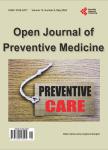Epidemiology of School-Related Injuries in Belgium. A Better Knowledge for a Better Prevention
Epidemiology of School-Related Injuries in Belgium. A Better Knowledge for a Better Prevention作者机构:Research Centre of Epidemiology Biostatistics and Clinical Research School of Public Health Université Libre de Bruxelles Brussels Belgium
出 版 物:《Open Journal of Preventive Medicine》 (预防医学期刊(英文))
年 卷 期:2014年第4卷第6期
页 面:408-420页
学科分类:1002[医学-临床医学] 100214[医学-肿瘤学] 10[医学]
主 题:School-Related Injuries Injury Determinants Cross-Sectional Survey Epidemiology
摘 要:The landmark Convention on the Rights of the Child states that children around the World have right to safe environment. In Belgium, as in many countries, children spend, on average, 4.5 weekdays at school, during nearly 8 hours per day. Studies have shown that, the risk of school-related injury exceeds the risk during leisure time. Literature reports that school accidents account for 10 to 30% of all accidents among pupils. Despite that, few papers treat of the school-related injuries. Consequently, based on 1540 accidents forms from an insurance company, injury places, mechanisms involved, body parts injured and nature of injuries were described. Head injuries, upper and lower limbs injuries were investigated in more details. Pearson’s chi-square test was used to assess the relationships between the variables and multivariate logistic regression models were used to study the three specific types of injuries cited above. Gender ratio (M/F) was equal to 1.6 with 25.9% of children under 6 years, 29.4% of 6 - 9 years, 26.9% of 10 - 12 years and 17.8% from 13 years or more. The major places of injuries were the playground (56.9%) and the physical education (19.7%). Falls were observed in 52.1% of cases and contacts were reported in 24.3%. The head injuries account for 40.6%, the upper limbs for 32.0% and the lower limbs injuries for 20.2%. The bruises and the scratches were observed in 23.8% and the wounds in 21.5%. Fractures were reported in 16.1%. In conclusion, having a routine access to the data from the insurance companies could be an important source of information for an injury surveillance system in which the school injuries will be included. Taking into account this data will require an awareness of all the concerned persons about the relevance of such a system and a harmonization of the accidental forms.



